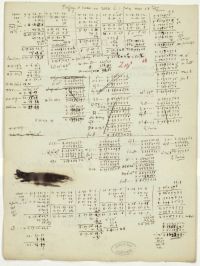|
Written on Venus's transit of 2004 and 2012 The transits preparation (ancient documents)Jean-Baptiste Delambre (1749-1822) was a student of Lalande. He became Science Academy Secretary in 1803. His manuscripts encompass various drafts for the correction of articles from l'Encyclopédie méthodique (the methodical encyclopaedia) edited by Panckouke. Delambre recalculated all the Venus transits with the help of the new astronomical tables from Lalande [[ 005 ]]. The leaflet noted "Z 151(4) 48" [[012 ]] concerns the 2004 transit. By this time, the date changed at noon: the instant noted "June 7, around 18h 1/2" therefore corresponds to June 8 around 6h 30 (at Paris time). Various calculations are given in sexagesimal (angles) and logarithmic (7 decimals) formats. The upper part of the manuscript shows some erased calculations. Delambre first calculated the heliocentric averaged longitudes of the Earth and Venus and performed the usual corrections. Then he determined the conjunction instant, and the middle of the geocentric transit time. He wrote down the hourly motion of the Sun and Venus, as well as Venus relative motion (94.64 "/h). One can read the distances between the astronomical objects ST, SV et TV and the geocentric internal contacts semi-duration (2h 39min 08s, noted here 2h.39'.8"). In reality, this duration was slightly longer by eight minutes. [Z 151 (4)] Delambre J.-B., Manuscripts (around 1785 ?), Paris observatory. Hind 1871, Proc.R.S-19 (1871) p. 423-425 [[ Proc.R.S-19 p.423-425 ]] Starting right from the end of the XIXth century, J. R. HIND (1823-1895) calculated the observing circumstances of the very late 2004 and 2012 transits from Le Verrier Tables. The instant of the right ascension conjunction for the 2004 transit was correct by less than 8 minutes, highlighting the very high precision of these end-of-the-XIXth century Tables. The predicted 2004 transit duration between the two internal contacts is too long by 9 minutes. The 2012 right ascension conjunction should occur 8 minutes earlier than the Hind predictions. The duration in between the contacts will actually be 2 minutes longer. Conclusion The Venus transits were extensively used to determine the solar parallax value. Unfortunately, the precision reached was not the one expected by Halley in 1716 (1/500 or 0.2 %). A lot of other methods do exist at the physics and astronomy interfaces, in order to determine this fundamental quantity: the Mars parallax, light speed and stellar aberration, perturbations of the Moon’s motion, the Earth mass. During the 20th century, new methods were used: measurement of the Eros 433 asteroid parallax (at a 0.172 UA distance from Earth) in January 1931, then radar echo on Venus at 0.284 UA from Earth during the April 1961 inner conjunction. Nowadays, the solar parallax is set to 8.794148", corresponding to a value of the astronomical unit 1 UA = 149 597 870 km. Seen from the Sun, Earth would appear with the apparent diameter of a 2 euros coin placed at… 300 m. Commented by Michel Toulmonde, Paris Observatory January 2004. |
